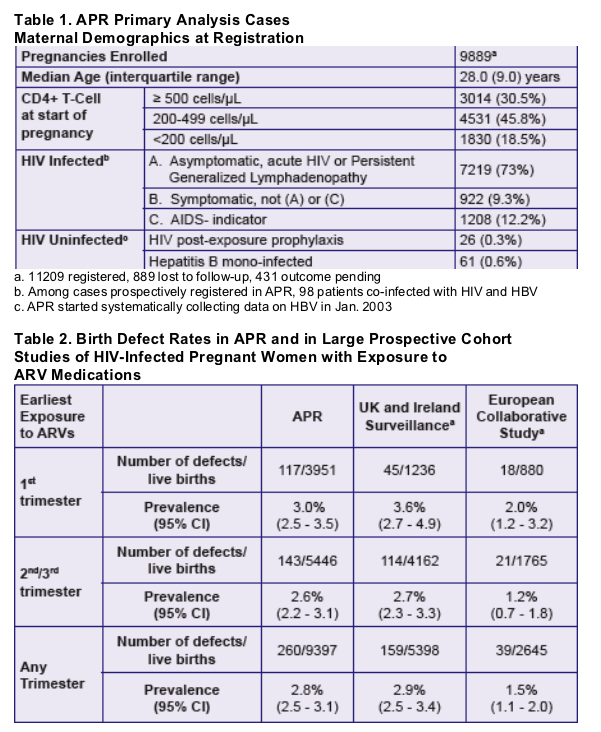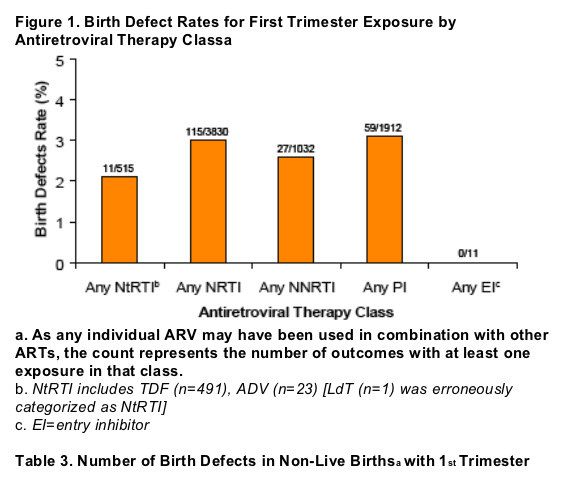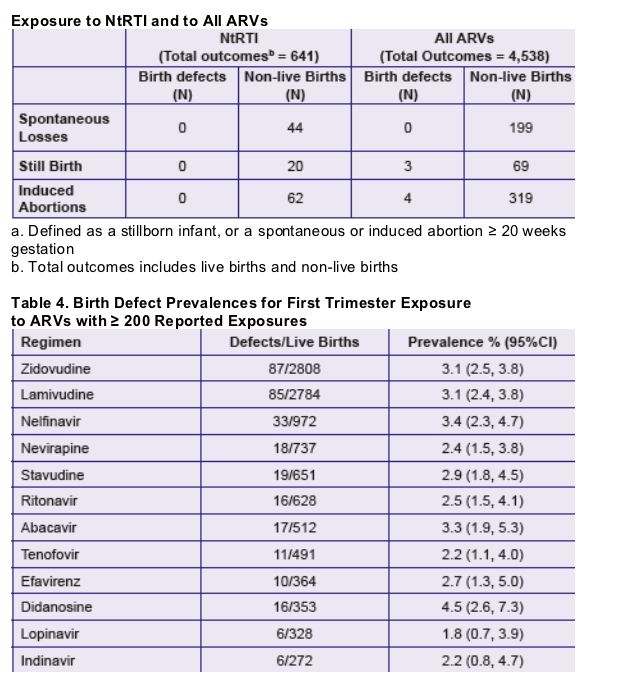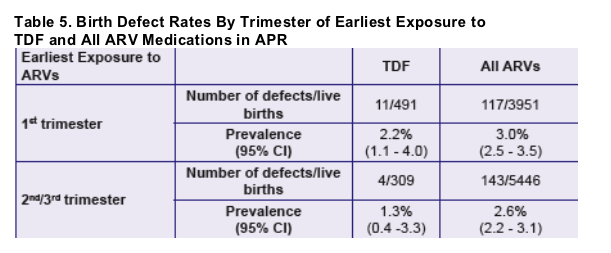 |
 |
 |
| |
Use of Tenofovir Disoproxil Fumarate (TDF) in Pregnancy: Findings from the Antiretroviral Pregnancy Registry (APR)
|
| |
| |
Reported by Jules Levin
ICAAC Oct 2008 Wash DC
B Olmscheid and S Zhang
Gilead Sciences, Inc., Foster City, CA, USA
APR Contact Information
APR website: www.APRegistry.com
Phone/Fax contacts:
US, Canada: (800) 258-4263 (Phone)
(800) 800-1052 (Fax)
International: +1-910-256-0238 (Phone)
+1-910-256-0637 (Fax)
UK, Germany, France: (00800) 5913-1359 (Phone)
(00800) 5812-1658 (Fax)
Europe: +32-2-714-5028 (Phone)
+32-2-714-5024 (Fax)
Success of the APR depends on
reporting of exposures by health care providers
INTRODUCTION
Tenofovir disoproxil fumarate (TDF), a nucleotide reverse transcriptase inhibitor (NtRTI), has been widely used in combination with other antiretroviral drugs for the treatment of chronic HIV-1 infection in adults
TDF is available in the following products:
-- TDF (Viread)
-- FTC (emtricitabine)/TDF (Truvada)
-- EFV (efavirenz)/FTC/TDF (Atripla)
TDF was recently approved for the treatment of chronic hepatitis B infection (HBV) in the EU region in April 2008 and in the U.S. in August 2008
TDF is classified as an FDA Pregnancy Category B drug (i.e. no evidence of
risk in animal studies; no adequate and well-controlled studies in humans)
BACKGROUND
Antiretrovirals (ARVs) were fi rst demonstrated to reduce mother-to-child transmission of HIV in ACTG Study 076, a study of zidovudine (ZDV) monotherapy compared to placebo, which was published in 19941
The CDC currently recommends ZDV and lamivudine (3TC) as the preferred
dual NRTI backbone for use in combination antiretroviral regimens in
pregnancy, while ZDV/3TC is no longer recommended as a preferred component of initial therapy for non-pregnant women2,3
Use of TDF-containing regimens in pregnancy and inclusion of TDF in treatment strategies for the Prevention of Maternal To Child Transmission (PMTCT) have been demonstrated to be well tolerated while reducing MTCT
both in animal models and in humans4,5,6,7
Birth defect rates in infants exposed in utero to ARVs are studied and reported
in a number of settings, including the Antiretroviral Pregnancy Registry
Antiretroviral Pregnancy Registry (APR) Background
An international prospective exposure-registration cohort study established in January 1989 to monitor major teratogenic effects of ARV drugs following exposure during pregnancy
Interim Primary Analysis reports are issued biannually
Inclusion criteria (for the Primary Analysis)
-- The pregnancy must be prospectively registered with the APR
-- Pregnancy outcome must be known and reported to the APR
An independent advisory committee consisting of members from CDC, FDA, and NIH provides oversight of the APR for scientific conduct and analysis
The current APR interim report has collected 11209 prospective cases and
includes data from January 1989 through January 31, 2008
APR began collecting data from exposure to TDF in 2001
METHODS
Based upon data from the primary analysis in the January 2008 interim APR report:
Identify overall birth defect rate for exposure to ARVs registered in the APR
Compare birth defect rate of:
-- 1st trimester NtRTI exposure to that of other ARV class exposure
-- 1st trimester NtRTI exposure to that of all ARVs in non-live births
-- Earliest TDF exposure to that of all ARVs in 1st or 2nd/3rd trimester
RESULTS

a. As reported in the APR interim report; data was collected December 1984-March 2007
Comparison to a Population-based Birth Defect Rate
CDC's population-based birth defects surveillance system, the Metropolitan Atlanta Congenital Defects Program (MACDP) reported total prevalence of birth defects of 2.72% of live births (1989-2003)
-- MACDP actively searches for birth defects among all births in five counties
of metropolitan Atlanta area with approximately 50,000 annual births
APR Advisory Consensus Statement
For the overall population exposed to antiretroviral drugs in this Registry,
no increases in risk of overall birth defects or specific defects have been
detected to date when compared with observed rates for "early diagnosis"
in population-based birth defects surveillance systems or with rates among
those with earliest exposure in the second or third trimester


APR Advisory Committee Consensus
Primary Registry Analysis (Prospective Reports)
In analyzing individual drugs with sufficient data to warrant a separate
analysis, an increased frequency for birth defects has been detected for
didanosine only
For abacavir, efavirenz, indinavir, lopinavir, nelfi navir, nevirapine, ritonavir,
stavudine, and tenofovir, sufficient numbers of first trimester exposures have
been monitored to detect at least a two-fold increase in risk of overall birth
defects. No such increases have been detected to date
For lamivudine and zidovudine sufficient numbers of first trimester exposures
have been monitored to detect at least a 1.5-fold increase in risk of overall
birth defects and a 2-fold increase in risk of birth defects in the more common
classes, cardiovascular and genitourinary systems. No such increases have
been detected to date with the exception of hypospadias following first
trimester exposure to zidovudine from the addition of the Women and
Infants Transmission Study (WITS) data

Limitations of APR Data
Limitations of the APR include, but are not limited to:
-- Underreporting (i.e., not every report of an exposure is obtained)
-- Differential reporting (i.e., there may be reasons why one report would be provided to the Registry and another would not)
-- Under ascertainment of birth defects (i.e., not every birth defect is identified, e.g., reporter may not see the defect at birth)
-- Differential ascertainment of birth defects (e.g., variable use of diagnostic tests)
-- Loss to follow-up (e.g., reports where no outcome information is obtained)
-- Data collected is not suffi cient to detect an increase in the risk of relatively
rare events
AUTHOR CONCLUSIONS
APR overall birth defect prevalence (2.8%) was comparable to that of other large prospective cohort studies of newborns with prenatal exposure to ARVs (2.9% and 1.5%) and to general population-based surveillance data (2.72%)
Birth defect prevalence with 1st trimester exposure to NtRTI class (TDF or ADV) was similar to that of 1st trimester exposure to other ARV classes
Birth defect prevalence with exposure to TDF was similar to birth defect rate with exposure to all ARVs
-- Earliest exposure in the first trimester (TDF 2.2%, all ARVs 3.0%)
-- Earliest exposure in the 2nd/3rd trimester (TDF 1.3%, all ARVs 2.6%)
Monitoring of birth defects among infants born to women with exposure to ARVs during pregnancy is important and should be encouraged
REFERENCES
1. Connor EM, et al. N Engl J Med 1994;331:1173-1180.
2. Recommendations for Use of Antiretroviral Drugs in Pregnant HIV-Infected Women for Maternal Health and Interventions to Reduce Perinatal Transmission in the United States. www.aidsinfo.nih.gov accessed September 24, 2008.
3. Guidelines for the Use of Antiretroviral Agents in HIV-1-Infected Adults and Adolescents -
January 29, 2008. www.aidsinfo.nih.gov accessed September 24, 2008
4. European Collaborative Study. Clin Infect Dis. 2005; 40(3):458-65.
5. European Collaborative Study. J Acquir Immune Defi c Syndr. 2003; 32(4):380-387.
6. Cooper ER, et al. JAIDS. 2002; 29:484-494.
7. Centers for Disease Control and Prevention. MMWR. June 2, 2006; 55(21):592-597.
|
| |
|
 |
 |
|
|